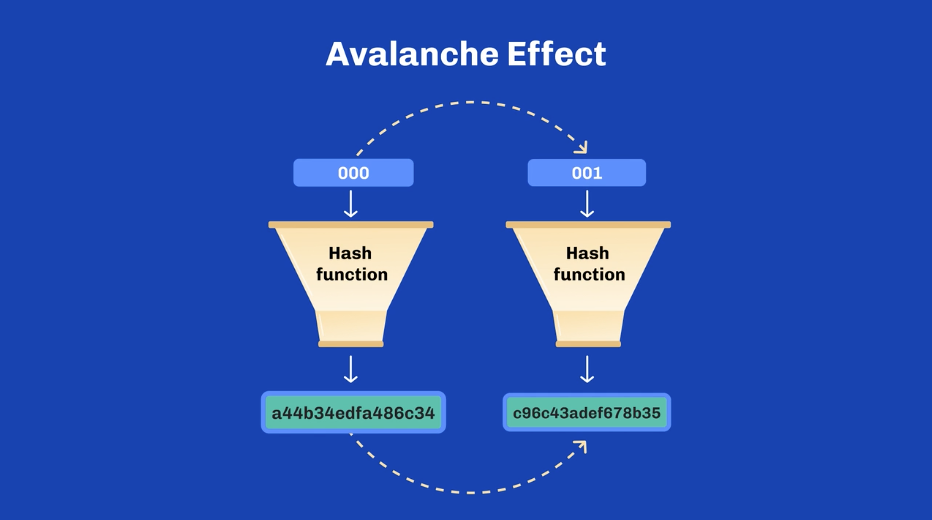The Avalanche Effect is a term used in cryptography to describe a desirable property of cryptographic algorithms, particularly in hashing and encryption functions. The Avalanche Effect occurs when a small change in the input (such as flipping a single bit) causes a significant and unpredictable change in the output. This property ensures that even minor variations in the input produce entirely different results, making it difficult to predict or reverse-engineer the original input based on the output.
In simpler terms, the Avalanche Effect ensures that small differences in input data lead to large differences in the output, making cryptographic systems secure by preventing attackers from correlating inputs and outputs to deduce information.

Importance of the Avalanche Effect in Cryptography
- Security: It helps prevent attackers from deducing the input data, even if they have access to the encrypted or hashed output.
- Unpredictability: Cryptographic systems rely on unpredictability to secure data, and the Avalanche Effect ensures that even a small change in input produces vastly different results.
- Resistance to Attacks: Systems that exhibit a strong Avalanche Effect are more resistant to various cryptographic attacks, such as differential cryptanalysis.
Relation to Cardano
In Cardano, cryptographic techniques are fundamental to securing the network, particularly through its use of hashing algorithms and encryption. The Avalanche Effect plays an essential role in the underlying cryptographic algorithms that secure transactions, verify identities, and maintain the integrity of the blockchain. For example, hash functions like SHA-256 (used in Cardano) rely on the Avalanche Effect to ensure that even the smallest change in transaction data results in a completely different hash output, making it nearly impossible to reverse-engineer or tamper with data.
Key areas where the Avalanche Effect is relevant in Cardano:
- Transaction Hashing: When transactions are hashed before being recorded on the blockchain, the Avalanche Effect ensures that small changes in the transaction data create completely different hashes, preventing unauthorized changes.
- Consensus Security: In Cardano’s Ouroboros proof-of-stake protocol, cryptographic techniques, including hashing with the Avalanche Effect, are used to secure and validate blocks, ensuring the robustness and integrity of the blockchain.
- Address Security: When wallet addresses or user identities are hashed, the Avalanche Effect ensures that even small changes in user information result in entirely different hashed outputs, making it difficult for attackers to infer user data.
Summary
Purpose:
The Avalanche Effect ensures that small changes in input data lead to large, unpredictable changes in output, making cryptographic systems more secure and resistant to attacks.
Key Function:
In Cardano, the Avalanche Effect helps secure transactions, user identities, and the overall blockchain by ensuring the unpredictability and security of cryptographic operations such as hashing.
Simplest Explanation:
The Avalanche Effect ensures that even tiny changes in input data create huge differences in the output, which protects sensitive data on blockchains like Cardano by making it harder to reverse or manipulate information.
The Avalanche Effect is a key component of cryptographic security in Cardano, protecting the blockchain’s transactions and data by making it extremely difficult for attackers to reverse-engineer or alter information.
FAQs about the Avalanche Effect and Cardano
1. What is the Avalanche Effect in cryptography?
The Avalanche Effect is a property of cryptographic algorithms where small changes in the input lead to large, unpredictable changes in the output, enhancing security.
2. How does the Avalanche Effect improve blockchain security?
The Avalanche Effect makes it difficult to predict or reverse-engineer input data (like transaction information) from its cryptographic output, thus improving security against tampering and unauthorized access.
3. Is the Avalanche Effect used in Cardano’s blockchain?
Yes, Cardano uses cryptographic hashing algorithms (such as SHA-256) that exhibit the Avalanche Effect to secure transactions, validate identities, and maintain the integrity of the blockchain.
4. Why is the Avalanche Effect important for Cardano transactions?
The Avalanche Effect ensures that even the smallest change in transaction data produces a completely different output, making it impossible for attackers to manipulate or reverse-engineer the transaction.
5. Does the Avalanche Effect help with Cardano’s staking system?
Yes, cryptographic functions that rely on the Avalanche Effect play a role in Cardano’s Ouroboros proof-of-stake consensus system, ensuring that block validation is secure and tamper-resistant.

Leave a Reply